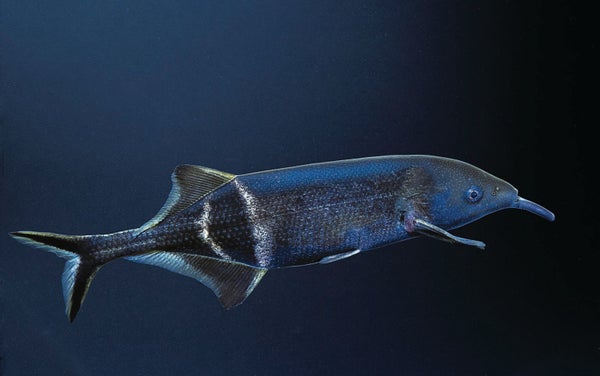Bats and dolphins are deservedly famous for their echolocation, but the elephantnose fish has a different superpower sense—electrolocation. And now new research suggests this bizarre-looking creature has to do an underwater jig to create the three-dimensional electric map it uses to “see” its surroundings.
Eyesight alone wouldn’t get the elephantnose very far in the murky rivers of western and central Africa where the nocturnal fish makes its home. So a specialized organ in its tail emits a weak electric field that radiates outward from its body in pulses, and tiny receptors on its skin detect distortions to the field caused by objects or creatures nearby.
These distortions create an “electric image”—a two-dimensional representation of the object being detected like a shadow cast on the fish’s skin. But researchers weren’t sure how the fish used that 2-D map to perceive a 3-D world.
On supporting science journalism
If you're enjoying this article, consider supporting our award-winning journalism by subscribing. By purchasing a subscription you are helping to ensure the future of impactful stories about the discoveries and ideas shaping our world today.
The answer, according to a new study published in Animal Behaviour, is that the elephantnose fish does a little aquatic dance. By wiggling around, it perceives objects from slightly different angles; stacked together, the various electric images it gets are enough for it to distinguish among 3-D objects.
“Fish are a lot more intelligent than people initially believe,” says the study’s first author Sarah Skeels, a postdoctoral researcher of animal cognition and behavior at the University of Oxford.
Skeels has been thoroughly charmed by the elephantnose fish, and it’s easy to see why. It’s got a face like Gonzo the Muppet because of what is technically called its schnauzenorgan—a fleshy protrusion from its chin that’s functionally a cross between an elephant’s trunk and an antenna. The schnauzenorgan is chock-full of electroreceptors and can also be used to manipulate objects as the fish roots around in riverbed silt for its dinner.
Despite its cautious nature, the elephantnose fish is inquisitive and is known for its strange exploratory behavior, Skeels says. When the fish encounters an unfamiliar object, it may bob its head, swivel its schnauzenorgan or swim backward toward the object and shake its electrically charged tail. It sometimes even “moonwalks” with a “sort of backward paddling movement” that’s very unusual in fish, Skeels says.
Skeels wanted to find out if these motions help the elephantnose perceive its surroundings, so she tried taking away the fish’s wiggle room to see if that affected its ability to distinguish between objects. She trained six Peters’s elephantnose fish to associate a sausage-shaped block of aluminum with a reward of tasty bloodworms. Then she presented the fish with a choice of two doors made of mesh to allow water and electric fields through. Behind one door, she placed an aluminum object shaped like a sausage, and behind the other door, she placed either a cube or a sphere.
After each fish went through several hundred training trials, it could pick the door that led to the sausage shape it associated with a treat in a matter of seconds, with an accuracy rate of 93 percent.
But then Skeels began to shrink the dance floor. Using mesh barriers, she incrementally narrowed the chambers in front of the doors so the fish had less room to shimmy, shake and throw it back. And the more cramped the quarters, the worse the fish’s performance got. At the narrowest setting, the dance floor was 2.5 inches across. The equivalent space for a human would be somewhere between the width of a doorway and an elevator, Skeels explains. (The fish were a little more than six inches long but very slender.)
With no room for their more flamboyant dance moves, the fish resorted to a lot of head bobbing and scanning with their schnauzenorgan. Their accuracy in locating the sausage-shaped object dipped to 71 percent, and they took longer to reach a decision—sometimes on the order of minutes. There was “a level of hesitancy you don’t see in the other trials,” Skeels says.
Stefan Mucha, a postdoc studying weakly electric fish at the Humboldt University of Berlin, says Skeels’s paper was “very cleverly designed” and demonstrated the importance of movement to electrolocation—a small but meaningful piece in the complex puzzle of how the fish integrate electrical information into a usable map.
Decades of research into the Peters’s elephantnose fish have already yielded impressive applications for human use. A team at the University of Bonn in Germany—including Gerhard von der Emde, a professor of sensory ecology and a co-author of the new study—has developed an underwater camera that was inspired by the elephantnose fish and generates its own “electric images” with a weak electric field. And computer engineers in Turkey have designed what they call the “electric fish optimization,” an algorithm based on the electrolocation and electrocommunication of weakly electric fish such as the elephantnose.
It’s no wonder the elephantnose fish has the highest brain-to-body weight ratio of any vertebrate, the researchers say. “It’s just so complex, what they do, that we can’t really model it with our greatest computers,” Mucha says. “But it’s just a small fish!”
A version of this article entitled “Shimmying Schnoz” was adapted for inclusion in the February 2024 issue of Scientific American.
